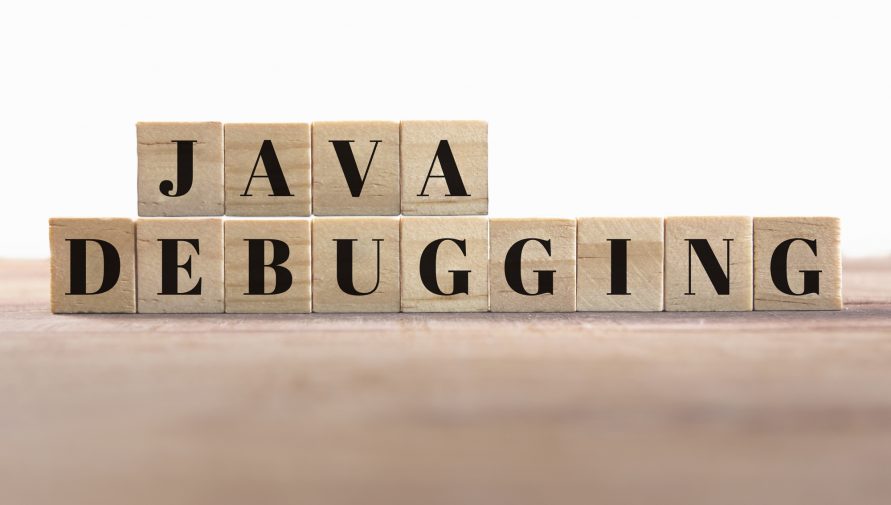6 Advanced Java Techniques of Debugging Software Programs
- Chetan Chaand
- June 23, 2022
- 11 Minute Read

In the world of software development, Java is a programming language that needs no introduction. Despite being a little shy of nearly three decades old, Java has managed to stay relevant by consistently offering value year after year and changing with the times. Even though we have entered an era of microservices and distributed software architectures, Java continues to reign supreme as the #1 programming language for it. In fact, as of 2021, almost 35.35% of software developers across the globe use Java as their preferred programming language.
Despite this widespread popularity, business leaders and non-tech decision-makers who fail to realize that Java comes in different forms and flavors having its own functional and executional benefits. For instance, we broadly have three editions of Java, namely, Basic Java, Core Java, and Advanced Java. Similarly, when you hire Java developers their expertise, along with their skill sets and qualifications, determines how well-versed they are in these Java platforms.
This blog aims to take a detailed look at the Advanced Java concepts, how it is different from Core Java, and the various Advanced Java debugging techniques to help companies realize their vision of a powerful and customer-friendly business application. So, let’s dive right in!
Difference Between Core Java and Advanced Java
As the name indicates, Core Java is the Java programming language and platform in its most fundamental form. It is typically used to develop general-purpose applications. On the other hand, Advanced Java programming primarily deals with modern-day online solutions, such as web or mobile applications. You can think of it as a specialization of Java in specific domains like networking, database handling, etc.
With this definition out of the way, let’s quickly take a look at the major differences between Core Java and Advanced Java through the following table:
| Core Java | Advanced Java | |
| Application | Used to develop general-purpose applications that could be cross-platform or platform-specific | Used to develop custom online applications for mobiles and desktops |
| Architecture | Core Java follows a single-tier architecture, which stores data on a shared drive or a local system. It has a monolithic structure with distinct Business, Data Access, and Presentation Layers. Hence the name ‘standalone applications.’ | Advanced Java is based on a two-tiered architecture, for example, the client-server architecture. Here, the Presentation or the Interface Layers run on the client-side while the Data Layer is on the server-side. |
| Java Packages | Contains packages following the naming convention of java.lang.*package | Contains packages following the naming convention of javax.servlet.*package |
| Skills | Developers working in Core Java must be proficient in Java Collections, data types, OOP Principles, Polymorphism, Exception Handling, Java Multithreading, etc. | Developers working with Advanced Java should have knowledge of Core Java as well as advanced concepts like DOM, servlets, RESTful development, XML handling, JSON parsing, JSP, web services, JDBC, Sockets, etc. |
| Edition | Java Standard Edition (J2SE) is the preferred platform for Core Java | Java Enterprise Edition (J2EE) is the preferred platform for Advanced Java |
Why Choose Advance Java For Software Development?
From the table in the previous section, it is evident that Advanced Java can cater to specific business requirements. But if we were to look at the larger picture, the benefits of using Advanced Java techniques for software development could be summarized as below:
- The client-server decoupling enhances the end user’s experience as the front-end look and feel is unrelated to the back-end functionality.
- Advanced Java has a simplified, component-based architecture. At the same time, it can give rise to complex, multi-tier applications.
- Application behavior can be configured during application assembly or deployment, which minimizes the need for recoding.
- The simple yet modular architecture enables quick and seamless development, deployment, and maintenance.
- It grants freedom while picking servers, tools, systems, and components.
- Several APIs, such as JDBC, JTA, JNDI, JMS, JavaMail, etc., help expand the scope by integrating with multitudes of existing information systems and databases.
- Advanced Java concepts enjoy a flexible security model powered by security-related APIs and single sign-on (SSO) access.
- Applications built using Advanced Java programming are highly scalable without the need for recoding or developing from scratch.
- Advanced Java-based applications come equipped with load balancers that can automatically handle resource allocation and data processing without affecting performance.
- It simplifies application maintenance as developers can update or replace components individually and independently.
The set of advantages listed above leaves little room for interpretation that Advanced Java concepts grant an apt medium for realizing futuristic, custom applications. These solutions are tightly coupled with business requirements, which make them instrumental to your business’ growth and development.
Role of an Advance Java Developer in IT or Software Development
When businesses decide to create applications using Advanced Java, they will have to hire a qualified Advanced Java developer. An Advanced Java developer having the right skill set and a good amount of expertise can effortlessly create digital, web-based solutions that integrate business logic. With this foundation, they can:
- Interact With Web Services
- Curate Responsive User Interfaces
- Build Bootstrap Components
- Perform Object-Relational Mapping
- Run CRUD Operations
- Manage Information on Databases
- Implement Best Design Practices
Advanced Java Approach to Debugging
Now that we have an in-depth understanding of Advanced Java technologies, let’s explore the most critical phase of any software development – yes, we’re talking about debugging.

Lumping the testing and debugging process for the entire application is one of the most catastrophic mistakes that developers make. And you will be surprised how often even veteran developers fall prey to this trap. As a result, debugging gets a bad rep, especially for Advanced Java.
However, if you were to simply embrace a methodical approach to debugging, it would be a lot easier and manageable. Typically, your approach to debugging in the Advanced Java environment should cover the following steps:
- Localizing: This step involves the identification of the bug and its underlying root causes. Once you notice a bug in the program, the next step is to locate the exact spot where the error has occurred. Generally, a bottom-up approach would be best suited to run through the code and efficiently identify the error.
- Analyzing: After zeroing down on the error, you need to perform a thorough analysis of it, starting with the identification and classification of the bug, followed by carrying out a risk assessment, identifying the collateral damage in isolating or fixing it, and so on. If required, you may have to prove these hypotheses through simulations.
- Isolation: As you may have discovered by now, bugs and errors can bleed into other elements of your application and bring down overall performance and productivity. As such, your first line of defense would be to isolate this problematic code or function so that it does not interfere with or impact other elements.
- Fixing: Finally, you need to fix the issue and run multiple tests to validate that the error has been resolved. Only release the update after the test scripts pass successfully.
With such a simple roadmap in place, debugging would not seem as overwhelming as it otherwise appears. While steps one to three are mostly intuitive and experience-based, developers can tweak their skills for step four through Advanced Java techniques for debugging, which we will discuss in the following section.
6 Advanced Java Techniques of Debugging

Once you have mastered the premise of debugging using the first three stages in the 4-step series listed in the previous section, it is all about executing strategies to address the issues. The various specialized Advance Java debugging techniques that will come into play can be broadly classified into the following strategies:
Use Breakpoints
A breakpoint is a deliberate inclusion of a line of code with the intention to stop or pause program execution at that specific point. During program execution, the breakpoint calls upon the debugger or creates an interruption at the CPU level. As a result, the program enters into exceptional handling mode.
Advanced Java developers either use conditional breakpoints or exception breakpoints to perform this task. Here’s a quick overview of what they offer:
- Conditional breakpoints are more suited for Eclipse IDE for they can follow a conditional approach to removing bugs in the program. Developers can create a breakpoint with a specified condition against which the breakpoint state will toggle to true once it is fulfilled. This change in state will cause the thread to pause or terminate at the breakpoint.
- On the other hand, exception breakpoints are primarily used to address NullPointerException or ArrayIndexOutofBoundException errors in the Eclipse and Netbeans IDE. The debugger will scour through the program and terminate execution when a programmed exception occurs. These are often used to prevent major faults.
Apart from these breakpoints, you also have watchpoints, which are essentially breakpoints set on a variable or a field. Every time the concerned variable or field is accessed or modified, the program execution will come to a halt so that you can debug.
Different debuggers using Advanced Java techniques for debugging software programs may have varying implementations of the conditional, validation, and control algorithms, which make them highly configurable against business requirements. For instance, some debuggers may completely terminate the application while others will perform data manipulation to allow executions to resume. Either way, it allows the Advanced Java developer absolute control over how they want things to pan out.
Print Debugging
Have you ever come across an error that causes the application to dump garbage values across the screen while it performs debugging? Then you already have a slight idea of what print debugging entails. This widely used Advanced Java debugging technique prints random values during application runtime and displays them at the console or user interface. It is often used by developers to comprehend the flow within the function or service and the logic or data transfer taking place in the background. The print statements are based on pure assumptions (rather than resting on logic) and are incorporated within the code depending on the developer’s judgment of where the bug resides.
Even though it is not one of the most reliable methods of Advanced Java debugging, it is widely used to prevent any minor errors such as problems with the flow of the application or unidentifiable code blocks responsible for the bug, and so on.
Remote Debugging
As the name indicates, this Advanced Java debugging technique takes place remotely wherein the debugger and the application are not colocated on the same server or platform. Such Advanced Java debugging technologies are often carried out in parallel with production debugging given their complementary nature.
When we create a software application for a single or a limited number of devices, it requires minimal resources. Such a limitation results in an architecture where the code for running the application and the code for debugging cannot co-exist. And here’s where remote debugging comes into the picture.
However, do not think that it is not useful for large-scale applications as such solutions often have a distributed architecture where remote debugging would also prove to be useful in maintaining modularity, flexibility, and scalability that non-monolithic ecosystems enjoy. Plus, developers can create remote debuggers for specific tasks, such as debugging certain microservices.
All you need to account for is linking the operating system and business application through configurable hooks that automatically trigger the debugging process. Once such a relationship has been established, any debugger can be transformed into a remote debugger.
Memory-Dump Debugging
A memory dump is a snapshot of the memory and corresponding data at a time when an application crashes. Think of it as a black box within an airplane. Developers can extract the ‘stack trace’ from this memory dump to comprehend exactly when, where, what, and how the program collapsed. The stack trace would contain a log of the various functions, values of global and local variables, and other critical data at the point of crash. Then, it is all about reverse-engineering the outcomes and tracing the causes that resulted in it.
However, developers can carry out memory dump debugging without waiting for a crash. In such cases, they would focus on the bugs that cause a function or a process to perform anomalously, thereby simulating a “micro-crash.”
This Advanced Java debugging technique can prove to be particularly useful if you run multiple Java applications that communicate with each other. Use memory-dump debugging to identify which application is responsible for the bug and work it out.
Replay Debugging
While memory dump debugging involves only a slight amount of reverse engineering, replay debugging dives right into it. With this form of Advanced Java debugging techniques, developers can analyze applications that have a well-defined flow from point A to point B. Using this flow as a reference, the developer can then trace the bug to the primary issue!
The Advanced Java Replay Debugging concepts require developers to record the entire process of program execution. During this step, they will replicate all data exchanges, events, memory management, data updates, user inputs, and output displays that would otherwise take place during the normal course of events.
Ideally, the developer should exhaust all permutations and combinations involved in program execution, especially those involving system interruptions and crashes. Once such a recording is created, they can replay this walkthrough step-by-step to identify what went wrong during execution. The replay debugging approach offers a holistic and inter-related overview of the entire process.
Watchpoints
Watchpoints is a dynamic approach to Java debugging where developers can monitor and analyze how variables change during program execution. If you want to track down bugs or understand the evolution of data within the code this is a useful technique.
By setting up watchpoints on specific variables developers receive a notification every time a change is made to the values of the variable. As a result, developers can find out the root cause of the issue with a streamlined data flow.
Key benefits consist of
- Developers can save time with automatic tracking of variable changes instead of manual intervention.
- Watchpoints don’t interrupt the program execution, unlike the conventional breakpoints. Developers can witness the changes without affecting the flow of the program
- Being supported by popular Integrated Development Environments (IDEs), watchpoints are accessible and straightforward to use for the majority of Java developers.
Advance Java Debugging Techniques: Some Tips and Tricks

Always remember that Advanced Java debugging techniques are neither singular nor one-off activities. If anything, it contains a series of systematic processes that you need to carry out repeatedly and periodically so that your business application is free from bugs and glitches. Against this background, you cannot afford to merely work hard; you also need to work smart. And to help you with the latter, here are a few tips and tricks that will help you stay on top of your game:
Prioritize the String Literal
While you can use exception breakpoints to combat NullPointerException, why let them occur in the first place? You can achieve this goal by putting the String “literal” to the left of an “equals()” comparison.
For instance, say you have the following line:
if (variable.equals(“literal”)) { … }
Consider replacing it with:
if (“literal”.equals(variable)) { … }
This slight consideration can work wonders without compromising on performance!
Prevent Accidental Assignment
Say you were to run a line that went like this:
if (variable = 5) { … }
It will result in an accidental variable assignment, which will then result in errors. In its place, consider something more concrete like:
if (5 = variable) { … }
Or:
if (5 === variable) { … }
By simply repositioning the expression to the left, you would be avoiding accidental assignment by displaying clear intent!
Check for Null & Length
While declaring an array or a collection, ensure that you define its length while explicitly declaring it to not be null.
Say, rather than this:
if (array.length > 0) { … }
Choose this:
if (array != null && array.length > 0) { … }
Such a deliberate declaration would define arrays clearly.
Ensure All Variables, Methods, and Parameters are Final
Set all variables, methods, and parameters as final.
Consider these bad examples:
Example 1
public void boom() { … }
Example 2
void input(String importantMessage) {
String answer = “…”;
answer = importantMessage = “LOL accident”;
}
And compare them with these better versions:
Example 1
public final void dontTouch() { … }
Example 2
final void input(final String importantMessage) {
final String answer = “…”;
}
Throw on Default Switch
Setting a default for your switch can set it right the first time without any need for debugging.
Here is an example that needs improvement:
switch (value) {
case 1: foo(); break;
case 2: bar(); break;
}
And here it is with the necessary tweaks:
switch (value) {
case 1: foo(); break;
case 2: bar(); break;
Default:
throw new ThreadDeath(“That should do it”);
}
The latter will ensure that your code can yield results even if the cases exceed to 3 and beyond.
Switch Using Curly Braces
Curly braces can help set aside cases for the switch statement. As an example, consider this lumpsum of a mess that may not even compile:
switch (value) {
case 1: int j = 1; break;
case 2: int j = 2; break;
}
In its place, here’s something that will make more sense:
switch (value) {
case 1: {
final int j = 1;
Break;
}
case 2: {
final int j = 2;
Break;
}
default:
throw new ThreadDeath(“That should do it”);
}
In the second example, the curly braces would introduce a multi-line scope for every case.
Closing Thoughts
Congrats on making it to the end of this exhaustive guide about Advanced Java techniques, debugging in particular. At this stage, you may be fairly confident that Advanced Java development is the trick to creating branded applications that enhance customer experience. However, do bear in mind that the anticipated Advanced Java techniques and resulting developments can only bear fruits if you have a capable Advanced Java developer at your disposal.
Of course, that’s not to say that you have to undertake the mammoth task of in-house recruitment as you can always hire an Advanced Java Developer through an agency, or simply outsource the task. With their niche code development, debugging, and maintenance skills, a developer having hands-on experience in Advanced Java technologies will definitely not disappoint!

Thank you for submitting the details!
We will keep your information safe. Feel free to contact us with any questions at hello@uplers.com
Please check your email for next steps shared by Robert.

















